weight AUDI S3 2009 Owners Manual
[x] Cancel search | Manufacturer: AUDI, Model Year: 2009, Model line: S3, Model: AUDI S3 2009Pages: 324, PDF Size: 76.02 MB
Page 5 of 324
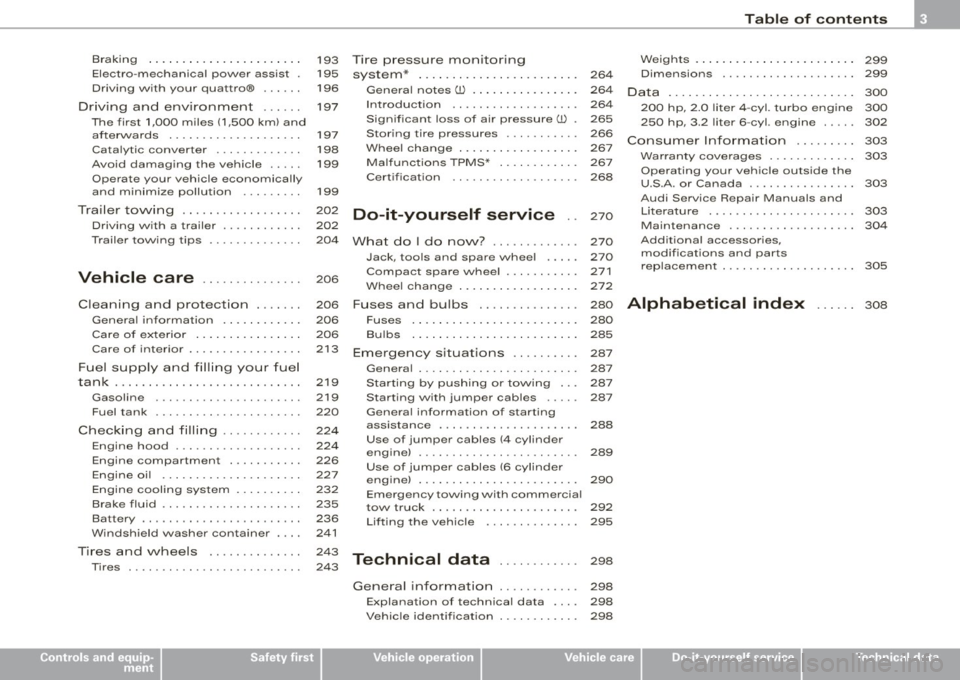
Braking .... ....... ... ..... ... .
E lectro -mechanical power assist .
Driving with your quattro® ..... .
Driving and enviro nment ..... .
The first 1,000 mi les (1,500 km) and
afterwards ................... .
Cata lytic converter .......... .. .
Avoid damaging the vehicle .... .
Ope rate your vehicle economically
and minimize pollution ........ .
Trailer towing ........... ...... .
Driv ing with a trailer ..... ...... .
Trailer tow ing tips ....... ... ... .
Vehicle care ... .......... . .
193
195
196
197
197
198
199
199
202
202
204
206 Tire pressure monitor ing
system* ....................... .
Genera l notes (l) ........ .• .. ... .
Introduct ion .................. .
Sign ifican t loss of air pressure
(l) .
Storing tire pressures .. ... ... .. .
Whee l cha nge .......... ....... .
Malfu nct io ns TP MS* ........... .
Cert ificat ion
Do-it-yourself service
W hat do I do now? ... ......... .
Jack, too ls and spare wheel .... .
Compact spare wheel .......... .
W hee l cha nge ... ... ... .. .. .. .. . 264
264
264
265
266
267
267
268
270
270
270
271
2
7 2
Table of contents
Weights . . . . . . . . . . . . . . . . . . . . . . . . 299
Dimensions . . . . . . . . . . . . . . . . . . . . 299
Data ............................ 300
200 hp, 2.0 liter 4-cyl. tu rbo eng ine 300
250 hp, 3.2 liter 6 -cyl. engine . . . . . 302
Co nsumer Info rma tio n ......... 303
Wa rranty cove rages . . . . . . . . . . . . . 303
Operating your vehicle outside the
U.S.A. or Canada . . . . . . . . . . . . . . . . 303
Audi Service Repair Manuals and
Li terature . . . . . . . . . . . . . . . . . . . . . . 303
Maintenance . . . . . . . . . . . . . . . . . . . 304
Additional accessories,
mod ifications and parts
rep lacemen t . . . . . . . . . . . . . . . . . . . . 305
Cleaning and protection . . . . . . . 206 Fuses and bulbs . . . . . . . . . . . . . . . 280 Alphabetical index ...... 308
Genera l info rmation ........... .
Care of exterior . ... ... .. .. ... . .
Care of interior ................ .
Fuel supply and fil ling your fue l
ta nk ........................... .
Gasoline ......... .. .... ...... .
Fuel tank ..... .......... ...... .
Checki ng and filling .. ........ . .
Engine hood .................. .
Engine compartment .......... .
Engine oil ............... ..... .
E ngine cooling system ......... .
Brake fluid ............... ..... .
Battery ....................... . 206
2
06
213
2 19
2 19
220
224
224
226
227
2 32
235
236
W indshield washer container . . . . 241
Tires and wheels
Tires ... ...... ..... ... ·. · · · · · · ·
Controls and equip
ment Safety first
243
243 Fuses . .
. . . . . . . . . . . . . . . . . . . . . . . 280
B ul bs . . . . . . . . . . . . . . . . . . . . . . . . . 28 5
Emergency situations . . . . . . . . . . 287
Genera l . . . . . . . . . . . . . . . . . . . . . . . . 287
Sta rting by pushing or towing . . . 287
Start ing with jumper cables . . . . . 287
Genera l information of sta rting
ass istance . . . . . . . . . . . . . . . . . . . . . 288
Use of jumper cab les (4 cylinder
eng ine) . . . . . . . . . . . . . . . . . . . . . . . . 289
Use of jumper cables (6 cylinder
engine) . . . . . . . . . . . . . . . . . . . . . . . . 290
Emergency towing with commercia l
tow truck . . . . . . . . . . . . . . . . . . . . . . 292
Lifting the vehicle . . . . . . . . . . . . . . 295
Technical data
General information
298
298
Explanation of technical data . . . . 298
Vehic le ide ntif ication . . . . . . . . . . . . 298
Vehicle operation Vehicle care Do-it-yourself service Technical data
Page 78 of 324
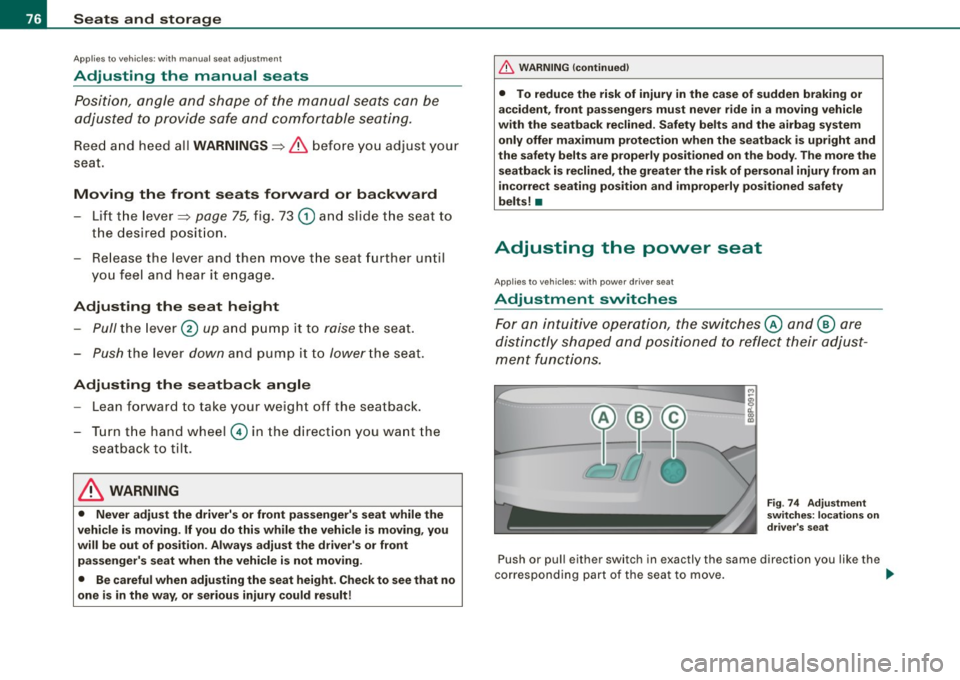
Seats and storage
Applies to vehicles : w ith m anual seat a djustm en t
Adjusting the manual seats
Po sition, angle and shape of the manual seats can be
adjusted to provide safe and comfortable seating.
Reed and heed all WARNINGS =:> & before you adjust your
seat.
Moving the front seats forward or backward
- Li ft the lever =:>
page 75, fig. 73 (D and slide the seat to
the desired p osition.
- Release the lever and then move the seat further until
you feel and hear it engage.
Adjusting the seat height
- Pull the lever @ up and pump it to raise the seat.
-Push the lever down and pump it to lower the seat .
Adjusting the seatback angle
- Lean forward to take your weight off the seatback.
- Turn the hand wheel© in the direction you want the
seatback to tilt.
& WARNING
• Never adjust the driver's or front passenger's seat while the
vehicle is moving . If you do this while the vehicle is moving , you
will be out of position . Always adjust the driver's or front
passenger's seat when the vehicle is not moving .
• Be careful when adjusting the seat height . Check to see that no
one is in the way, or serious injury could result!
& WARNING (continued)
• To reduce the risk of injury in the case of sudden braking or
accident, front passengers must never ride in a moving vehicle
with the seatback reclined. Safety belts and the airbag system
only offer maximum protection when the seatback is upright and
the safety belts are properly positioned on the body . The more the
seatback is reclined, the greater the risk of personal injury from an
incorrect seating position and improperly positioned safety
belts! •
Adjusting the power seat
Applies to vehi cles : wi th p ow er dr iv e r s eat
Adjustment switches
For an intuitive operation, the switches @ and @ are
distinctly shaped and posi tioned to reflect their adjust
ment functions.
Fig . 7 4 Adjustment
switches: locations on
driver's seat
Push or pul l either switch in exactly the same direction you like the
co rresponding part of the seat to move. .,,
Page 86 of 324
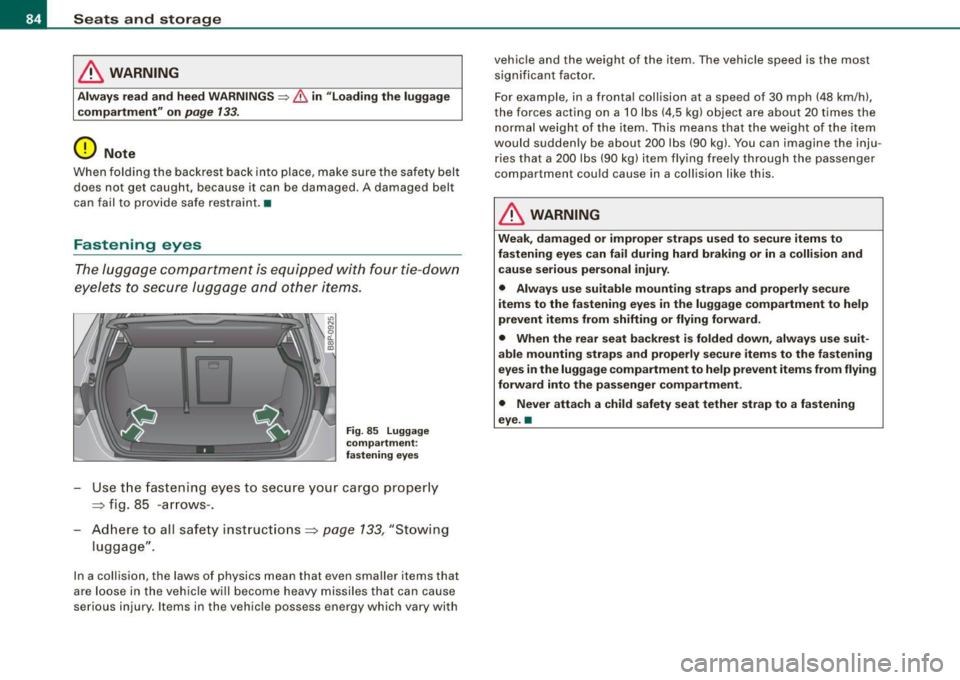
Seats and storage
& WARNING
Always read and heed WARNINGS => & in uloading the luggage
c ompartment " on
page 133 .
0 Note
When folding the backre st back into place, make su re the safe ty belt
does not get caught, because it can be damaged . A damaged belt
can fail to p rov ide safe restraint. •
Fastening eyes
The luggage compartmen t is e qui pped with four tie -down
eyele ts to secure lug ga ge and o ther items .
Fig. 85 Lugg age
compartment :
fa stening eyes
Use t he fastening e yes to secu re you r ca rgo pr oper ly
=> fig. 85 -a rr ow s-.
- Ad here to all safet y instruc tions => page 133, "Stowing
lugg age".
In a collision, the laws of physics mean that even smalle r items that
a re loo se in t he vehi cle will bec ome he avy missiles that ca n ca use
se rious inju ry . I tems in the vehicle possess e nergy which vary with vehicle and the weight of the item
. T he vehicle speed is the most
significan t factor.
For exam ple, in a fronta l collision at a speed of 3 0 mph (48 km/h),
the forces acting on a 10 lbs ( 4,5 k g) object are about 20 times the
n ormal w eight of th e ite m. Th is mea ns that the weight of the it em
woul d suddenly be about 200 lbs (90 kg). You can imagine the inju
ri es th at a 20 0 lb s (90 kg) item fl ying fr ee ly t hroug h the passe nge r
compartment cou ld cause in a co llis ion li ke this.
& WARNING
Weak , damaged or improper straps used to secure items to
fastening eyes can fail during hard braking or in a collision and cause serious personal injury .
• Always use suitable mounting straps and properly secure
items to the fastening eyes in the luggage compartment to help
prevent items from shifting or flying forward.
• When the rear seat backrest is folded down , always use suit
able mounting straps and properly secure items to the fastening
eyes in the luggage compartment to help prevent item s from flying
forward into the passenger compartment .
• Never attach a child safety seat tether strap to a fastening
eye. a
Page 88 of 324

Seats and storage
& WARNING
For strength-related reasons, heavy objects must not be hung on
the hooks. Heavy objects are not adequately secured -this
increases the risk of injury. •
Retractable luggage compartment cover
The luggage compartment cover keeps luggage or other
objects out of view.
Fig. 89 Rear lid open
with luggage compart ment cover
Removing the luggage compartment cover
Detach the retaining straps=> fig. 89 at the rear hatch G).
-Pull the cover 0 horizontally out of the mount@ in the
direction of the arrow.
Installing the luggage compartment cover
- Push the cover horizontally into the mounts provided
=> fig. 89@ on the side panel until the cover seats.
- Install the retaining straps in the rear hatch => fig. 89
G)
=>& .
& WARNING
• The luggage compartment cover must never be installed
without being secured -this creates an accident hazard.
• Whenever driving, never place any hard or heavy objects on the
luggage compartment or allow pets to sit on the luggage compart
ment cover . They could become a hazard to vehicle occupants in
the event of sudden braking or in an accident.
0 Note
Make sure that the heating wires in the rear lid do not get damaged
by objects scraping against them.
[ i ] Tips
• You can use the luggage compartment cover to store light
weight clothing but do not leave any heavy or sharp objects in the
pockets of the clothing.
• Remember that placing clothing on the luggage compartment
cover can block the driver's vision in the rear view mirror. This also
applies especially when you have to transport large objects.
• So that stale air can escape from the vehicle be sure not to cover
the ventilation slot between the rear lid and the luggage compart
ment cover installed. •
Page 93 of 324
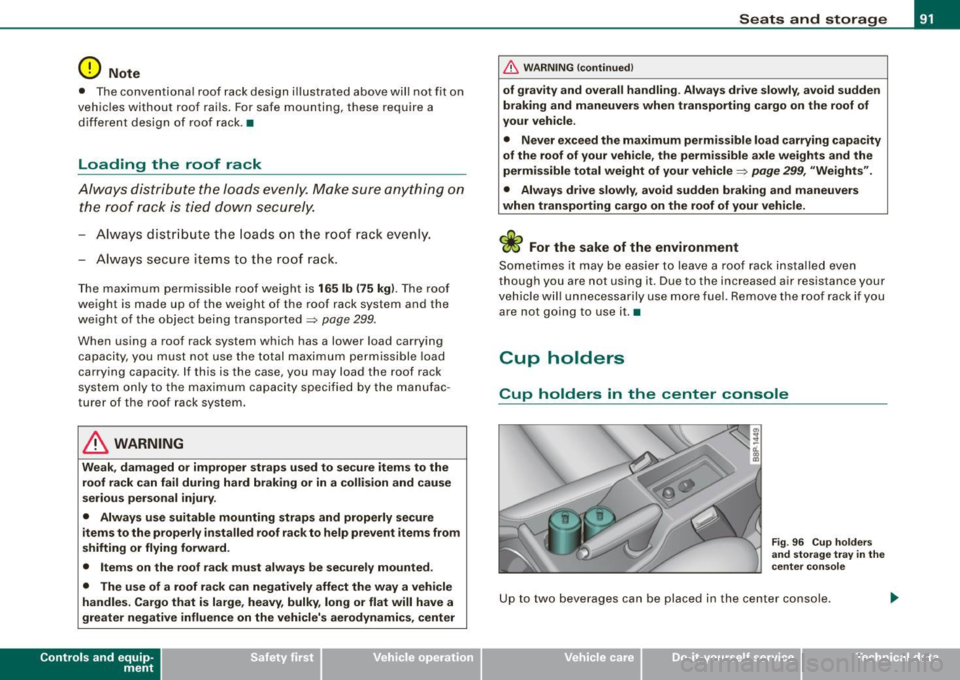
0 Note
• The conventiona l roof rack design illustrated above will not fit on
vehic les without roof rai ls . For safe mounting, these require a
different design of roof rack .•
Loading the roof rack
Al ways di stri bute the loads evenly . M ake sure any thing on
the roof r ack is tied dow n se cu rely.
- A lways distr ibute the loa ds on the r oof rack evenly .
- Alw ays secure items to t he roo f rack.
The maximu m permissi ble roof weight is 165 lb (75 kg ). The roof
weight is made up of the weight of the roof rack system and the
weight of the object bei ng transported =>
page 299.
When using a roof rack system which has a lower load carrying
capacity, you must not use the t otal maximum permis sible load
carrying capacity . If this is the case, you may load the roof rack
system on ly to the maximum capac ity specifie d by the manufac
turer of the roof rack system.
& WARNING
Weak , damaged or improper straps used to secu re items to the
roof rack can fail durin g hard braking or in a collision and cause
s erio us personal injury .
• Alway s use suitable mounting strap s and properly secure
item s to the properly in stalled roof rack to help pre vent items from
shifting or flying forward .
• Items on the roof rack must al ways be securely mounted .
• The u se of a roof ra ck can negatively affect the way a vehi cle
handles . Cargo that is large , heavy, bulky , long or flat will have a
greater negative influenc e on the vehicle 's aerodynamics, center
Con tro ls and eq uip
ment
Seats and storag e
& WARNING !continued )
of gravity and overall handling . Alwa ys drive slowly , avoid sudden
braking and maneuver s when tr ansporting cargo on the roof of
your vehicle .
• Nev er e xceed the ma ximum permi ssible load car rying capacity
of the roof of your v eh ic le, the permissible axle w eights and the
pe rmis sible tot al weight of your vehicle=>
page 299, "Weight s".
• Always drive s lo w ly, avoid sudden br aking and maneuvers
when tran sporting cargo on the roof of your vehicle .
~ For the sake of the environment
Sometimes it may be easier to leave a roof rack installed even
though you are not using it. Due to the increased air resistance your
ve hic le w ill unnecessarily use more fue l. Remove the roof rack i f yo u
are not going to use it .•
Cup holders
Cup holders in the center console
F ig . 96 Cup hol ders
an d s torag e tray in th e
ce nte r c ons ole
Up to two beverages can be placed in the center console .
Vehicle care I I irechnical data
Page 96 of 324
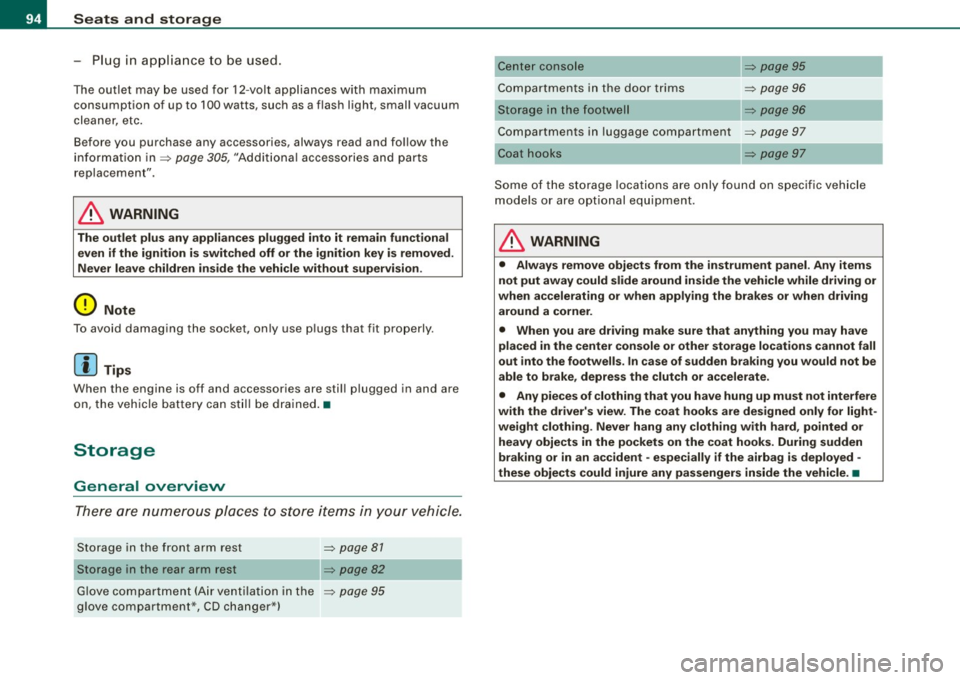
Seats and storage
-Plu g in ap plia n ce to be us ed.
The ou tlet may be used for 12-volt app liances with maximum
consumption of up to 100 watts, such as a flash light , smal l vacuum
cleaner, etc .
Before you purchase any accessories, always read and follow the
inf orm ati on i n
=> page 305 , "Addi tiona l ac cess ories and parts
replacement" .
& WARNING
The outlet plu s any appliances plugged into it remain functional
even if the ignition is switched off or the ignition key is removed .
Ne ver leave children inside the vehicle without supervi sion .
0 Note
To avoid damaging the socket, only use p lugs that fit properly .
[ i ] Tips
When the engine is off and accessories are sti ll plugged in and are
on, the vehicle batte ry can sti ll be d rained .•
Storage
General overview
There are numer ous pl aces to store items i n your ve hicle.
Storage in the front arm rest
Storage in t h e rear ar m res t
=> page 87
Glove compart ment (A ir v enti lati on i n t he ::::> page 95
glove compartment*, CD changer *) Cent
er console
Compartments in the door trims
S to ra ge in the f ootwe ll
=> page9 5
=> page96
=> page96
Compartments in luggage compartment => page 97
Some of the s torage locations are only found on specific veh icle
models or are optional equ ipment .
& WARNING
• Always remove obje cts from the in strument panel. Any items
not put away could slide around inside the vehicle while driving or
when a ccelerating or when applying the bra kes or when driving
around a corner .
• When you are driving make sure that anything you may have
placed in the center console or other storage locations cannot fall
out into the footwells . In case of sudden bra king you would not be
able to brake , depress the clut ch or accelerate .
• Any pie ces of clothing that you have hung up mu st not interfere
with the driver's view. The coat hooks are designed only for light
weight clothing . Never hang any clothing with hard , pointed or
heavy objects in the pockets on the coat hooks . During sudden
bra king or in an accident -especially if the airbag is deployed -
these obje cts could in jure any passengers inside the vehicle. •
Page 99 of 324
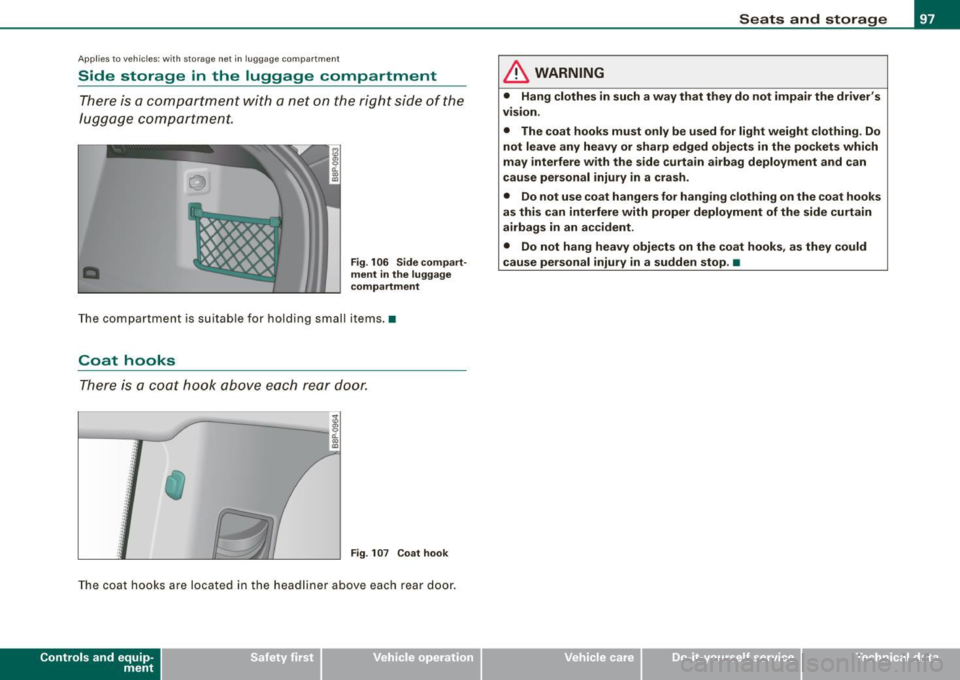
Applies to veh ic les : w it h stora ge net in lu ggage compa rtm ent
Side storage in the luggage compartment
There is a comportment with a net on the right side of the
luggage comportment.
•
Fig . 106 Side compart
ment in the luggage
compartment
The compartment is suitable for holding small items. •
Coat hooks
There is a coot hook above each rear door.
:I ,,
;:
J ' t
" ::·
/
}
· : : .: ,, 1
} Fig . 107 Coat hook
The coat hooks are located in the headliner above each rear door.
Con tro ls and eq uip
ment
Seats and storage
& WARNING
• Hang clothes in such a way that they do not impair the driver's
v1s1on.
• The coat hooks must only be used for light weight clothing. Do
not leave any heavy or sharp edged objects in the pockets which
may interfere with the side curtain airbag deployment and can
cause personal injury in a crash.
• Do not use coat hangers for hanging clothing on the coat hooks
as this can interfere with proper deployment of the side curtain
airbags in an accident.
• Do not hang heavy objects on the coat hooks, as they could
cause personal injury in a sudden stop. •
Vehicle care
I I Technical data
Page 116 of 324

• .___O_ n_ t_h _e _ r_o _a_ d __________________________________________________ _
CRUISE (US model)/ r,,f (Canadian model) will also light up in the
instrument cluster.
& WARNING
• Always pay attention to traffic even when the cruise control is
switched on. You are always responsible for your speed and the
distance between your vehicle and other vehicles.
• For safety reasons, the cruise control should not be used in the
city, in stop-and-go traffic, on twisting roads and when road condi
tions are poor (such as ice, fog, gravel, heavy rain and hydro
planing) -risk of accident.
• Turn off the cruise control temporarily when entering turn
lanes, highway exit lanes or in construction zones.
• Please note that inadvertently "resting" your foot on the accel
erator pedal causes the cruise control not to brake. This is because
the cruise control is overridden by the driver's acceleration.
[ i J Tips
• Vehicles with manual transmission : You can attain the set speed
only if the currently engaged gear allows it and the engine is not
stressed. Shifting to a higher or lower gear promptly will allow the
engine to run smoothly.
• The cruise control cannot maintain a constant speed when
driving downhill. The vehicle will accelerate under its own weight.
Downshift to a lower gear or use the brakes to slow down. •
Changing speed
- Press lever in the 0 or Q direction~ page 113, fig. 116
to increase or decrease your speed.
Release the lever to save that speed .
Change speed in increments of 1 mph (1 km/h) by lightly pressing
the lever. If you keep the lever pressed down, you will alter your
speed in 5 mph (10 km/h) increments.
You can also press the accelerator pedal down to increase your
speed, e .g. if you want to pass someone. The speed you saved
earlier will resume as soon as you release the accelerator pedal.
If, however, you exceed your saved speed by 5 mph (10 km/h) for
longer than 5 minutes, the cruise control will turn off temporarily.
The symbol will go out but the saved speed will be retained. •
Presetting your sp eed
You can preset your desired speed while the vehicle is not
moving.
- Turn on the ignition.
Pull lever into position
G) ~ page 113, fig. 116.
Press the lever in the
0 or Q direction to increase or
decrease your speed.
- Release the lever to save that speed.
This function makes it possible, for example, to save the speed you
want before driving on the highway. Once on the highway, activate
the cruise control by pulling the lever toward
G) . •
Switching th e system off
Temporary deactivation
Press the brake pedal, or
- Keep the clutch pedal pressed down
longer, or
Press the lever into position
0 (not clicked into place)
~ page 113, fig. 116, or ._
Page 136 of 324

........ _o_ r_iv _i_ n""' g::;._ S_ a_f _e _ly =---------------------------------------------------
& WARNING
Improperly stored luggage or other items can fly through the
vehicle causing serious personal injury in the event of hard braking or an accident. To help reduce the risk of serious personal injury:
• Always put objects, for example, luggage or other heavy items
in the luggage compartment.
• Always secure objects in the luggage compartment using the
tie-down eyelets and suitable straps.
& WARNING
Heavy loads will influence the way your vehicle handles. To help
reduce the risk of a loss of control leading to serious personal
injury :
• Always keep in mind when transporting heavy objects, that a
change in the center of gravity can also cause changes in vehicle
handling:
-Always distribute the load as evenly as possible.
- Place heavy objects as far forward in the luggage compart-
ment as possible.
• Never exceed the Gross Axle Weight Rating or the Gross
Vehicle Weight Rating specified on the safety compliance sticker on the left door jamb. Exceeding permissible weight standards
can cause the vehicle to slide and handle differently.
• Please observe information on safe driving~
page 126.
& WARNING
To help prevent poisonous exhaust gas from being drawn into the
vehicle, always keep the rear lid closed while driving.
• Never transport objects larger than those fitting completely
into the luggage area because the rear lid cannot be fully closed.
& WARNING (continued)
• If you absolutely must drive with the rear lid open, observe the
following notes to reduce the risk of poisoning :
- Close all windows,
- Close the power roof*,
- Open all air outlets in the instrument panel,
- Switch off the air recirculation,
- Set the fresh air fan to the highest speed.
& WARNING
Always make sure that the doors , all windows, the power roof*
and the read lid are securely closed and locked to reduce the risk
of injury when the vehicle is not being used.
• After closing the rear lid, always make sure that it is properly
closed and locked .
• Never leave your vehicle unattended especially with the rear lid
left open. A child could crawl into the vehicle through the luggage
compartment and close the rear lid becoming trapped and unable
to get out . Being trapped in a vehicle can lead to serious personal
injury.
• Never let children play in or around the vehicle.
• Never let passengers ride in the luggage compartment. Vehicle
occupants must always be properly restrained in one of the
vehicle's seating positions.
[ i] Tips
The tire pressure must correspond to the load -see the tire pressure
sticker on the fuel filler door. •
Page 137 of 324

Driving Safely -
----------------
Tie-downs
The luggage compartment is equipped with four tie
downs to secure luggage and other items.
Use the tie -downs to secure your cargo properly~ page 133,
"Loading the luggage compartment".
In a collision, the laws of physics mean that even smaller items that
are loose in the vehicle will become heavy missiles that can cause
serious injury. Items in the vehicle possess energy which vary with
vehicle speed and the weight of the item. Vehicle speed is the most
significant factor.
For example, in a frontal collision at a speed of 30 mph (48 km/h),
the forces acting on a 10-lb (4.5 kg) object are about 20 times the
normal weight of the item. This means that the weight of the item
would suddenly be about 200 lbs. (90 kg). You can imagine the inju
ries that a 200 lbs. (90 kg) item flying freely through the passenger
compartment could cause in a collision like this.
& WARNING
Weak, damaged or improper straps used to secure items to tie
downs can fail during hard braking or in a collision and cause
serious personal injury.
• Always use suitable mounting straps and properly secure
items to the tie-downs in the luggage compartment to help
prevent items from shifting or flying forward as dangerous
missiles.
• When the rear seat backrest is folded down, always use suit
able mounting straps and properly secure items to the tie-downs
in the luggage compartment to help prevent items from flying
forward as dangerous missiles into the passenger compartment.
• Never attach a child safety seat tether strap to a tie-down. •
Controls and equip ment Safety first Vehicle operation
Reporting Safety Defects
Applicable to U.S.A. If you believe that your vehicle has a defect
which could cause a crash or could cause injury or death, you should immediately inform
the National Highway Traffic Safety Adminis
tration (NHTSA) in addition to notifying Audi of
America, Inc.
If NHTSA receives similar complaints, it may
open an investigation, and if it finds that a
safety defects exists in a group of vehicles, it may order a recall and remedy campaign.
However, NHTSA cannot become involved in
individual problems between you, your dealer,
or Audi of America, Inc.
To contact NHTSA, you may call the Vehicle
Safety Hot
Ii ne to I I-free at:
Tel.: 1-888-327-4236 (TTY: 1-800-424-9153) or write to:
Administrator NHTSA 1200 New Jersey Avenue, SE
Washington, D.C. 20590
Vehicle care Do-it-yourself service Technical data